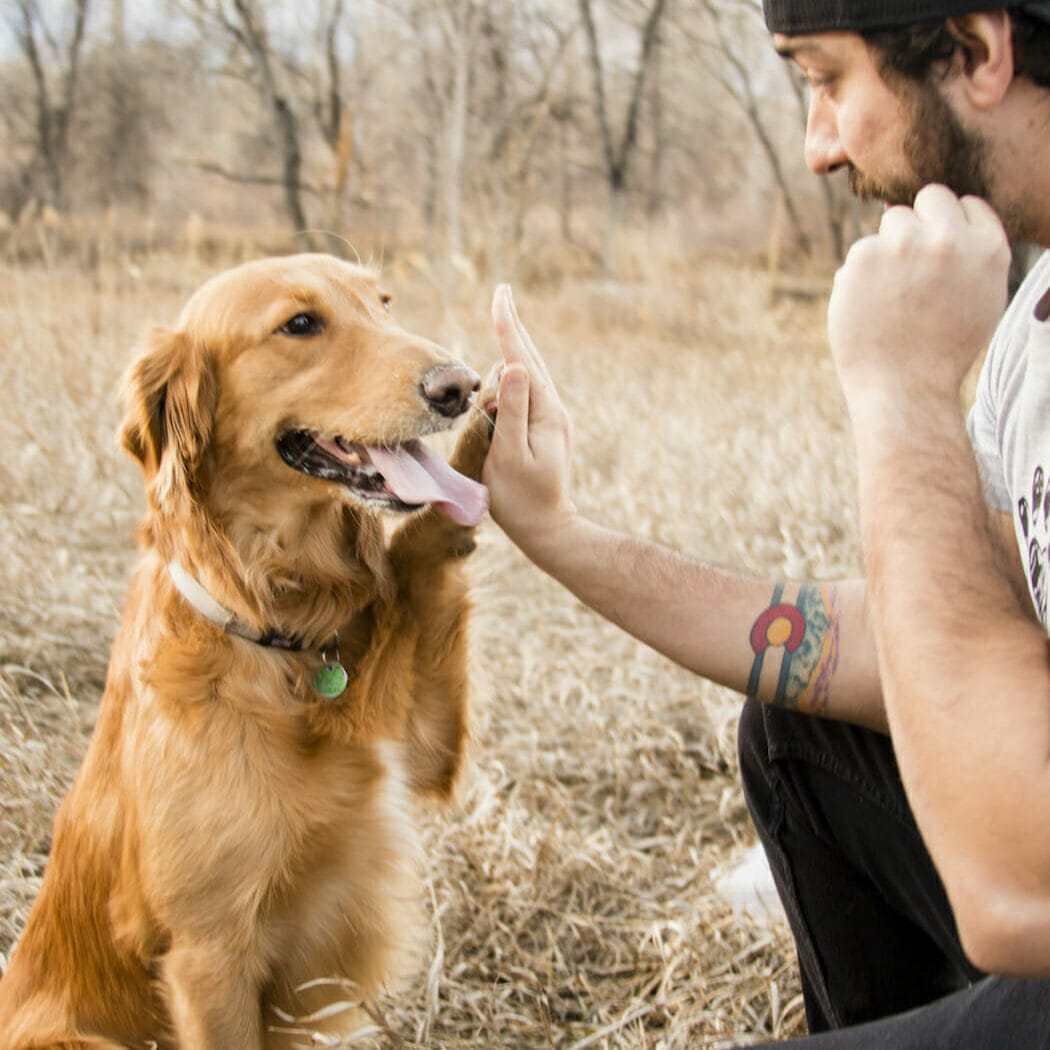What you may think are strange behaviors in your dog could be completely normal. To better understand your dog, it’s important to learn their body language as well as what causes these common dog behaviors. From tail wagging to excessive digging, gain an understanding of your dog’s needs to strengthen the bond you share together. We’re here to help with these dog behaviors explained.
Learn Dog Body Language
If you want dog behaviors explained to you by your dog, you first have to look at their body language. Understanding your dog’s body language is crucial for interpreting their emotions, intentions, and needs. One of the first places to look is the ears. When they’re perked up, it usually means your dog is alert and interested in something. If they’re laid back, your dog may be feeling submissive or friendly. Ears pinned back are generally a sign that your dog is afraid of something.
The eyes can also be very telling. Wide-open and alert eyes usually indicate that your dog is paying attention or excited. An averted gaze can mean that the dog is submissive. If your dog has half-closed eyes, they’re likely relaxed, sleepy, or content. Be cautious if your dog is giving a direct stare, as this could indicate a challenge or focus and isn’t always friendly. The whale eye, where your dog is staring out of the corner of their eyes, could be an early warning sign of aggressive behavior.
Your dog’s tail also provides significant clues. A fast-wagging tail is usually a sign of excitement or happiness. If the tail is high and still, your dog is alert and interested, but you should approach cautiously. A low tail or one between the legs usually signals that the dog is submissive, anxious, or fearful. A slow wag often means your dog is relaxed and content.
In terms of body position, a dog that is standing tall and leaning forward is likely confident and may be asserting dominance or showing interest. A lowered body or crouching stance usually signifies that your dog wants to play. If your dog is lying down with their belly up, they’re generally highly submissive and showing they trust you. Paws up usually indicate that your dog is playful and seeking attention.
In canine body language, yawning is often considered a sign of discomfort or a pacifying behavior intended to defuse social tension. When a dog yawns in response to seeing a human yawn, they could be attempting to communicate comfort or relaxation. Yawning may also promote a calming effect in dogs.
Finally, the mouth offers more clues. An open and relaxed mouth generally signals contentment or slight excitement. A closed mouth usually indicates that the dog is relaxed but alert. Be cautious if you see lips curled with teeth visible; this is a warning sign that your dog feels threatened and might become aggressive. Panting can be due to heat, but it might also signify excitement or stress.
Remember, these are general guidelines, and each dog will have their own unique dog body language. Always consider the full context and consult professionals if you’re unsure of your dog’s behavior. Use caution when learning a new dog’s behavior.
Common Dog Behaviors Explained
Understanding common dog behaviors can go a long way toward fostering a happy and healthy relationship with your canine companion. While most common dog behaviors can vary between individuals, understanding these common behaviors and their underlying causes can be a helpful guide to interpreting what your pet is trying to communicate, allowing you to address their needs more effectively.
1. Tail Wagging Meaning
We’ve often been told that a wagging tail means a happy dog. However, the tail’s position and movement can convey different messages. A fast wagging tail usually indicates excitement or happiness. If your dog wags their tail slowly, it can indicate they’re relaxed or content. If the tail is high and still, your dog is alert and interested but also potentially cautious. A low tail or one between the legs usually indicates that the dog is submissive or fearful.
2. Why Your Dog Tilts Their Head
While the exact reason isn’t universally agreed upon, several theories exist regarding why dogs tilt their head. One popular explanation is that tilting the head helps dogs better localize a sound or understand its origin, essentially fine-tuning their already keen sense of hearing.
Another theory suggests that the head tilt allows dogs to see past their snouts, giving them a clearer visual perspective of the person speaking or of the object they’re focused on. Some animal behaviorists also believe that dogs may tilt their heads as a social cue, indicating attentiveness or curiosity, possibly even to elicit a positive response from their human caregivers.
Cognitive aspects, such as trying to comprehend a new sound or command, may also contribute to this endearing behavior. No matter the reason, the head tilt is just another example of the charming ways dogs interact with their environment and their human companions.
3. Zoomies is a Normal Behavior in Dogs
The term “zoomies” refers to those sudden bursts of energy that you’ve probably seen your dog exhibit, often characterized by frantic, repetitive circling, darting back and forth, or playfully bounding around your living room or yard. This behavior is formally known as Frenetic Random Activity Periods (FRAPs). While it might seem like pure craziness, zoomies are actually a natural and generally harmless way for dogs to release pent-up energy.
They can occur for various reasons, such as excitement, when they’re feeling particularly playful, or even right after a bath. Zoomies are most commonly seen in puppies and younger dogs, but they can occur in dogs of all ages. While usually harmless, it’s essential to ensure that the environment is safe for your dog when they get the zoomies—away from busy streets or hazardous objects at home—to prevent accidents.
If your dog regularly exhibits zoomies, it could also be a sign that they may need more regular exercise to help them burn off that extra energy. Bring them for an extra walk or jog each day, play fetch, or find another activity they enjoy. A tired dog is a happy dog.
4. Excessive Licking Behavior
Excessive licking behavior in dogs can be both perplexing and concerning for pet owners. While occasional licking is a normal canine behavior often used for grooming or showing affection, persistent or obsessive licking could be caused by underlying medical problems.
If dogs lick excessively, it can lead to health problems, especially if the dog licks the same spot consistently. To prevent excessive licking, it’s essential to first identify the root cause. A thorough veterinary examination can help rule out medical issues.
If the problem appears to be behavioral, a certified dog behaviorist may help in developing a treatment plan. Implementing environmental changes, providing mental stimulation through toys and activities, and using positive reinforcement techniques can also help manage normal stress and distract from the licking.
5. Howling Is Instinctive Communication
Howling is an instinctual behavior that is deeply ingrained in a dog’s ancestry, dating back to when they were once wolves. It’s in your dog’s DNA. While domesticated dogs don’t necessarily howl for the same reasons wolves do, the behavior persists for various reasons. Some dogs howl as a form of long-distance communication or to attract attention. Others might howl in response to certain high-pitched sounds, like sirens or musical instruments, possibly because they resemble the frequency of another dog’s howl.
Howling can also be a sign of discomfort or even excitement in some cases. It’s worth noting that some breeds are more prone to howling than others. Understanding the context and triggers for your dog’s howling can provide insights into why they’re doing it and whether it’s a benign behavior or something that requires attention.
6. Eating Poop Is Common
Even though eating poop is among the most common dog behaviors, it’s not exactly appealing. Understanding why your dog engages in this behavior is the first step to effectively preventing it. Eating poop, scientifically known as coprophagia, can be caused by several different factors, including:
- Nutritional deficiencies: A lack of certain nutrients may lead a dog to seek out feces as a food source.
- Instinct: In the wild, eating feces may have been a survival mechanism to remove scent markers that predators could use to track.
- Behavioral reasons: Puppies may mimic their mother’s behavior of eating their feces to keep the den clean.
- Boredom: Some dogs may engage in this behavior out of boredom or to gain attention. Keep in mind that even negative attention is still attention.
- Health concern: Talk to your vet about the medical conditions that could trigger coprophagia.
Preventing Coprophagia in Dogs
If you suspect your dog has nutritional deficiencies, it’s crucial to consult your veterinarian for a professional evaluation or a nutritionist to evaluate your dog’s diet. Another straightforward preventative measure is to promptly clean up any feces from your yard or walking areas, removing the temptation altogether.
If you observe your dog approaching feces with interest, employing distraction techniques can be effective. You could use a toy, treat, or command to divert their attention. Basic obedience training is also invaluable; teaching commands like “leave it” or “come” can help you call your dog away from certain objects or behaviors. If the problem persists, a veterinary consultation is advisable to rule out any medical issues that might be contributing to the behavior
7. Why Dogs Bark And What It Means
Barking is a natural form of canine communication and serves various purposes, like alerting them to danger, signaling excitement, or asking for attention. Different types of barking can convey different messages. A high-pitched, repetitive bark may indicate excitement or alertness, while a deep, prolonged bark could be a sign of a threat.
If a dog begins to bark incessantly, it’s no surprise that dog owners could become overwhelmed. Excessive barking can occur for several reasons, and identifying the underlying cause is crucial for effective management. Here are some common triggers:
- Attention-seeking: Dogs tend to bark excessively to get attention from their owners or other people.
- Boredom: Most dogs lacking physical or mental stimulation may resort to barking to pass the time.
- Fear: Stressful situations, unfamiliar environments, or specific phobias can cause some dogs to bark excessively.
- Alerting: Many dogs will bark to alert their owners to various stimuli, like people approaching the home or other animals in the vicinity.
- Social barking: Dogs sometimes bark excessively in response to hearing other dogs bark, a behavior known as “responsive barking.”
Prevent Dogs From Barking Excessively
Physical and mental stimulation can play a significant role in curbing excessive barking. A dog that is regularly exercised and mentally engaged is less likely to bark out of boredom or frustration. Training is another vital component; using commands like “quiet” or “no bark” and rewarding your dog for obedience can be effective, but consistency is key.
Ignoring the behavior may get your dog to stop barking if it is attention-seeking, but it might not work if the barking is in response to alerts. For dogs that bark in response to specific stimuli, gradual desensitization can help. This involves slowly introducing the dog to the triggering situation, starting at a low level of intensity and gradually ramping it up, all while rewarding your dog for not barking. Keep in mind that older dogs may not know what they’re barking at, so bringing them to the vet as soon as you notice abnormal behavior is important.
CBD for Dogs may also promote a sense of relaxation and mental alertness without drowsiness. That’s why it’s often recommended for behavioral problem management.
If these methods are not effective or the problem becomes disruptive, it may be necessary to consult a veterinarian or a dog trainer for professional advice. Overall, understanding the root cause of your dog’s barking and applying targeted interventions can help transform a noisy environment into a more peaceful one.
8. The Reason Behind Excessive Digging
Dogs dig for a variety of reasons, some of which are instinctual while others may depend on their environment or emotional state. Here are some common reasons:
- Boredom: A dog that is not getting enough mental and physical exercise may turn to digging as a way to expend energy and stave off boredom.
- Instinct: Some breeds have a natural inclination to dig. Terriers, for example, were bred to dig for prey, and this instinct can still manifest in domestic settings.
- Den behavior: In the wild, dogs dig to create dens as a way of finding shelter. Some domestic dogs retain this instinct and may dig in an attempt to create a safe space.
- Storage: Dogs may dig holes to hide food, toys, or other “treasures” as a natural survival behavior. Many dogs love a certain toy or bone and will hide it so no other animals can have it.
- To maintain calmness: Digging may help dogs exhibiting nervousness, hyperactivity, discontentment, or responding to environmentally-induced stress.
How to Stop Excessive Digging
One of the most effective ways to stop excessive digging is to make sure your dog is adequately exercised and mentally stimulated. This can include walks, playtime, and mental puzzles like treat-dispensing toys. You can provide your dog with other activities that can use up their energy and satisfy their urge to dig, like chew toys or a digging box filled with sand where they can dig safely.
You should also consider:
- Training: Train your dog to understand the command “no dig” and reward them with treats and affection when they stop digging. Always use positive reinforcement rather than punishment.
- Creating barriers: In some cases, physical barriers like chicken wire under the soil or fences around flower beds can be effective at preventing digging.
- Dog trainer or vet: In severe cases, consult a vet or a certified dog behaviorist to rule out potential medical issues and develop a tailored treatment plan.
For further reading, we recommend:
- https://www.frontiersin.org/articles/10.3389/fvets.2018.00257/full?utm_source=FWEB&utm_medium=NBLOG&utm_campaign=ECO_FVETS_dog-body-language
- https://www.ncbi.nlm.nih.gov/pmc/articles/PMC6116041/
- https://www.sciencedirect.com/science/article/abs/pii/S1558787811001225
- https://www.ncbi.nlm.nih.gov/pmc/articles/PMC5980124/#:~:text=The%20coprophagic%20dogs%20in%20this,no%20older%20than%202%20days
- https://www.sciencedirect.com/science/article/abs/pii/S1558787818301552
- https://www.researchgate.net/publication/342657293_Beynen_AC_2020_Diet_and_canine_coprophagy
- https://pubmed.ncbi.nlm.nih.gov/9170633/
- https://pubmed.ncbi.nlm.nih.gov/36747107/
You Might Also Enjoy
Reactive dog barking may sound intimidating, but it’s important to differentiate it from dog aggression.…
Your dog’s skin is their largest organ making dog skin care a crucial part of…
Like us, our dogs, and other mammalian species, cats have an endocannabinoid system. This system…






